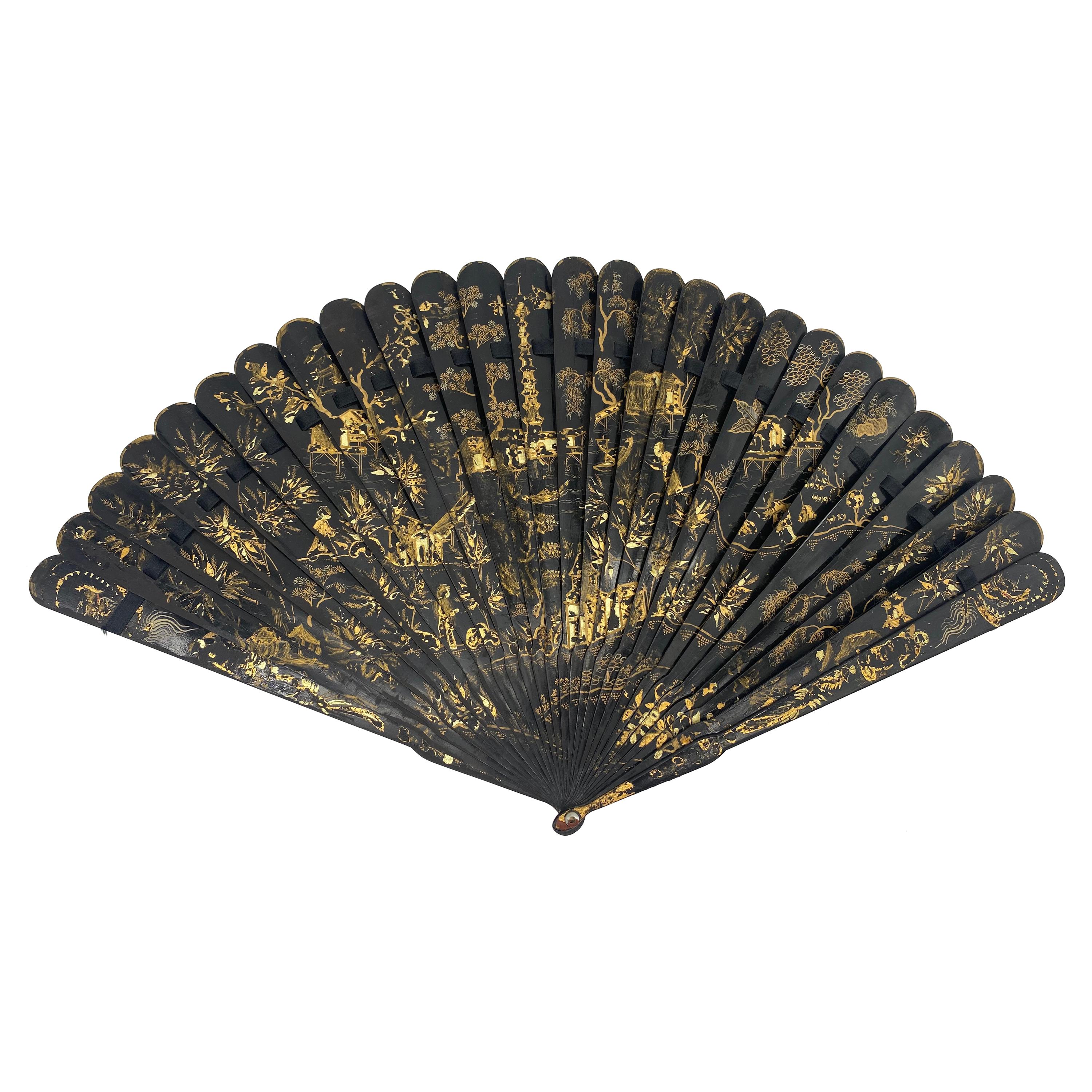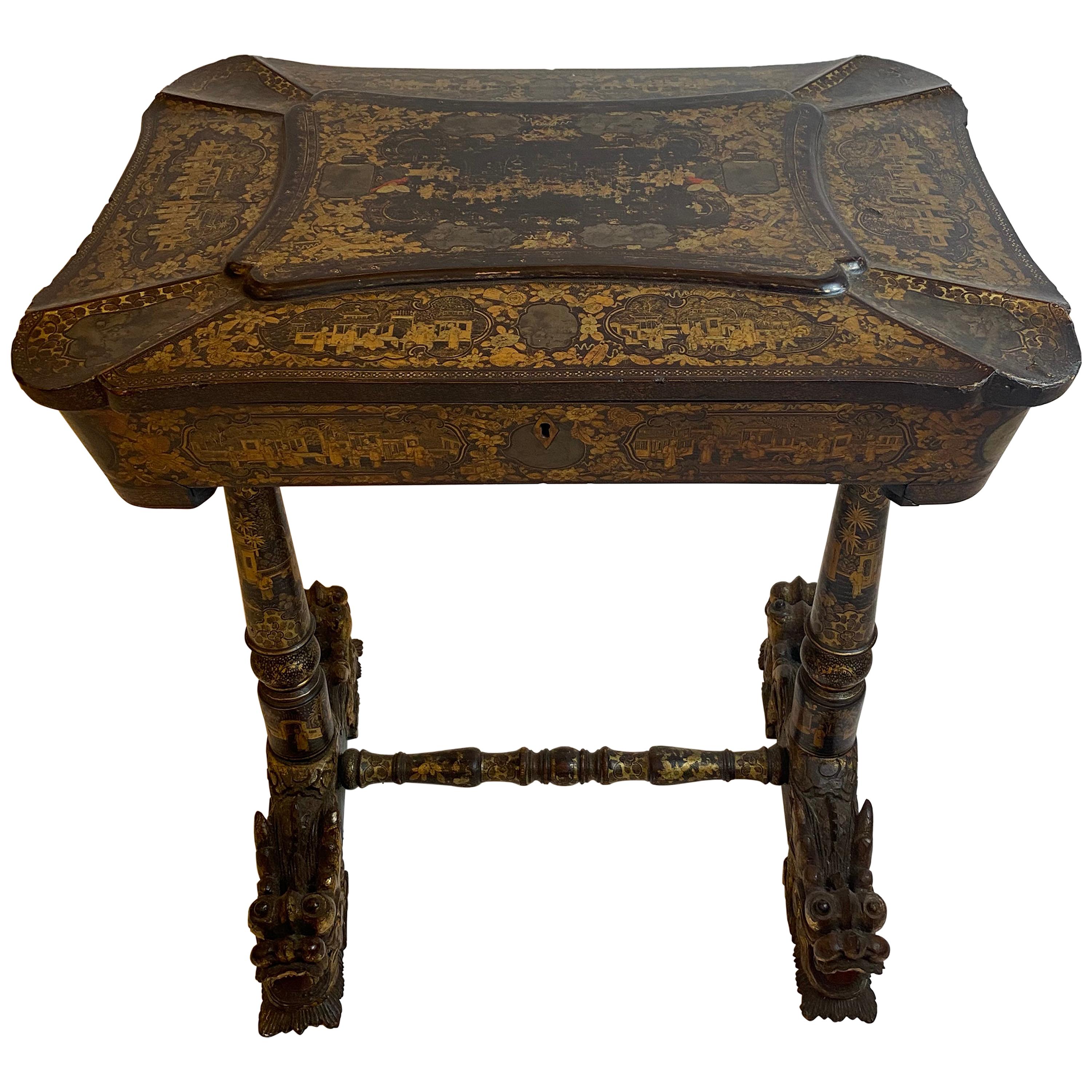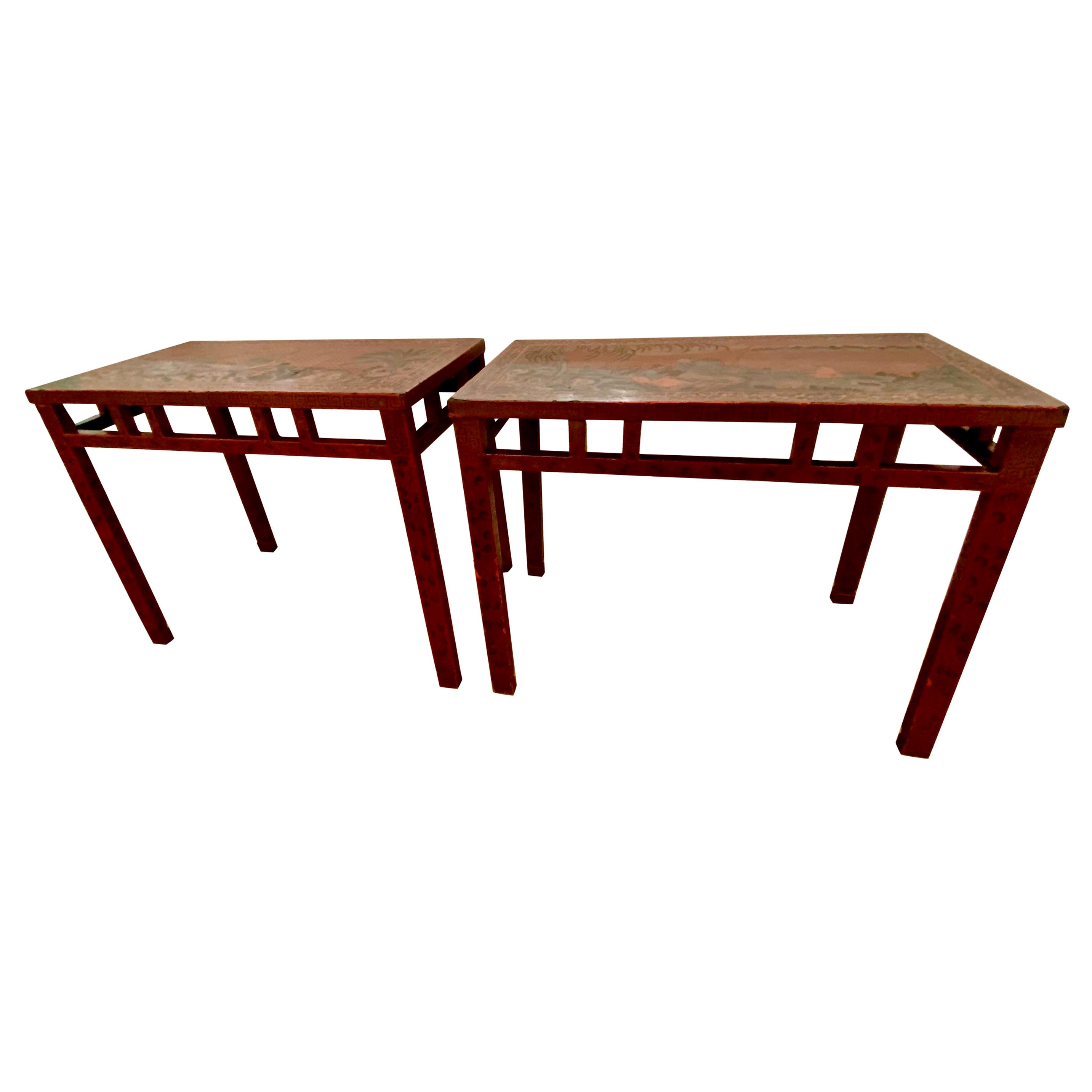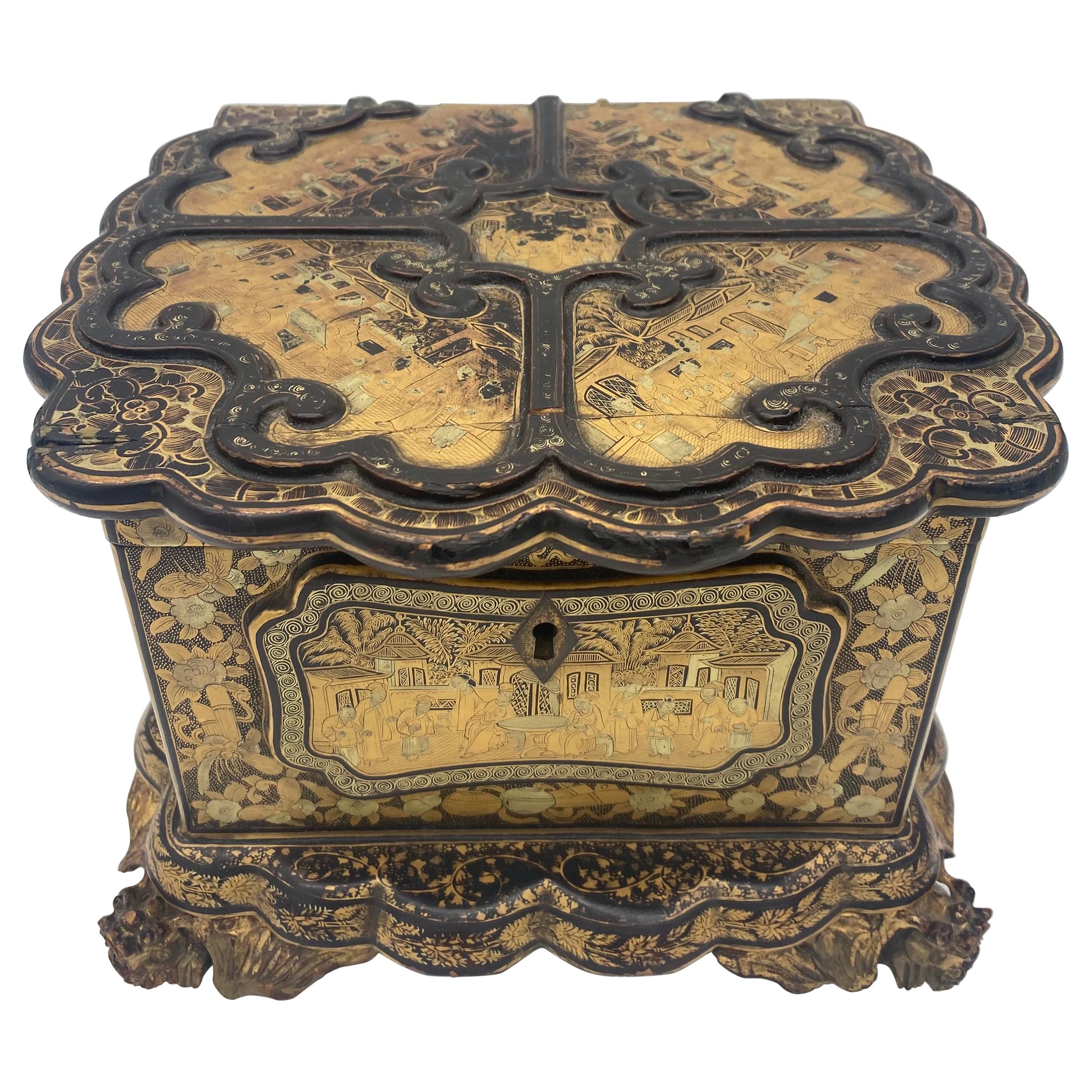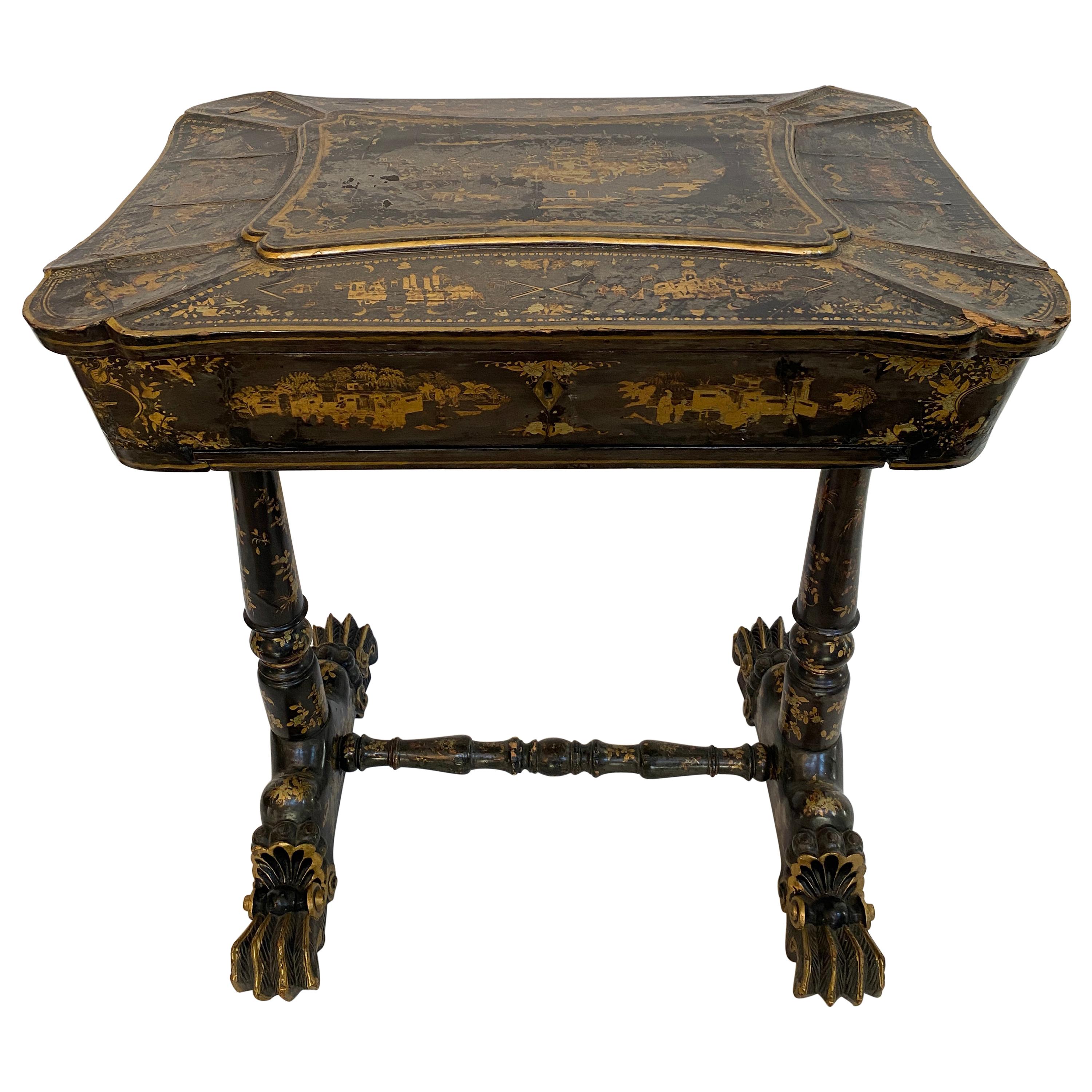Items Similar to 19th Century Chinese Export Lacquer and Gilt Davenport Desk
Want more images or videos?
Request additional images or videos from the seller
1 of 20
19th Century Chinese Export Lacquer and Gilt Davenport Desk
About the Item
Early 19th century Chinese export lacquer and gilt Davenport desk, the entire finely decorated with the typical figural landscape and foliate gilt decoration, the sloped top opening to reveal a fitted interior with stationary divisions, above recessed knee hole space and four side drawers to each side, on rope twist supports and carved gilt dragon head feet.
- Dimensions:Height: 34 in (86.36 cm)Width: 21 in (53.34 cm)Depth: 25 in (63.5 cm)
- Style:Qing (Of the Period)
- Materials and Techniques:Lacquer,Lacquered
- Place of Origin:
- Period:
- Date of Manufacture:Early 19th Century
- Condition:Wear consistent with age and use.
- Seller Location:Brea, CA
- Reference Number:1stDibs: LU5292220095112
About the Seller
4.4
Vetted Seller
These experienced sellers undergo a comprehensive evaluation by our team of in-house experts.
1stDibs seller since 2020
53 sales on 1stDibs
Typical response time: 2 hours
- ShippingRetrieving quote...Ships From: Brea, CA
- Return PolicyA return for this item may be initiated within 7 days of delivery.
More From This SellerView All
- Early 19th Century Chinese Export Lacquer and Gilt Work TableLocated in Brea, CAEarly 19th century Chinese export lacquer and gilt work table from the Qing Dynasty, with carved gilt dragon head feet, with the table of canted rectangular form, with moulded top, t...Category
Antique Early 19th Century Chinese Qing Lacquer
MaterialsLacquer
- 19th Century Chinese Canton Export Gilt Lacquer Brise FanLocated in Brea, CAAntique 19th century Chinese canton export gilt lacquer brise fan from the Qing Dynasty.Category
Antique 19th Century Chinese Qing Lacquer
MaterialsLacquer
- Unique 19th Century Export Chinese Gilt Chinoiserie Lacquer BoxLocated in Brea, CAUnique 19th century export Chinese gilt chinoiserie lacquer box with hand painted scenes gilt export black lacquer, this box has a unique shape, it is f...Category
Antique Mid-19th Century Chinese Qing Lacquer
MaterialsLacquer
- Early 19th Century Chinese Export Lacquer and Gilt Sew Working TableLocated in Brea, CAEarly 19th century Chinese export lacquer and gilt sew working table from the Qing dynasty, with carved gilt dragon head feet, with the table of canted rectangular form, with mounded...Category
Antique Mid-19th Century Chinese Qing Lacquer
MaterialsLacquer
- Antique 19th Century Export Chinese Gilt Chinoiserie Lacquer Gaming BoxLocated in Brea, CAAntique 19th century export Chinese lacquer gaming box with hand painted scenes gilt export black lacquer, there are 8 gaming boxes and 6 trays, highly ...Category
Antique Mid-19th Century Chinese Qing Lacquer
MaterialsLacquer
- 19th Century Chinese Export Lacquer Chess and Backgammon BoardLocated in Brea, CAA 19th century Chinese export lacquer chess and backgammon board 50 cm x 50 cm with gold black lacquer board, with white and red counters ...Category
Antique Mid-19th Century Chinese Qing Lacquer
MaterialsLacquer
You May Also Like
- 18th Century Chinese Export Lacquer Chinoiserie Bureau Desk for the Dutch MarketLocated in Amsterdam, NLAn extremely rare, possibly unique, Chinese export lacquer bureau for the Dutch market Canton, circa 1737 H. 118 x W. 102.5 x D. 63 cm Provenance: - Private collection, The Netherlands - J.K. Driessen Antiques, Arnhem (Art Fair Breda, 1989) - Noble collection, Belgium Literature: - C.J.A. Jörg, ’De handel van de V.O.C. in Oosters lakwerk in de 18de eeuw’ in: Nederlands Kunsthistorisch Jaarboek , Jr. 31 (1980), pp. 355-363 (ill.) - Annigje Hofstede, Nederlandse meubelen van Barok tot Biedermeier, 1700-1830, Waanders, Zwolle 2004, pp. 35-37 (ill.) This lacquer bureau is one of the four writing desks purchased in Canton in 1737, and as far as is known, this is the only remaining bureau of its type from the period. As the VOC believed that large pieces of import took up too much valuable space in their trading ships...Category
Antique Mid-18th Century Chinese Chinese Export Lacquer
MaterialsWood, Cypress, Lacquer
- Chinese Altar Tables, 19th C. LacquerLocated in Pasadena, CAThis is an unusual pair of Late Ching Chinese cinnabar-toned coromandel lacquer small altar or side tables. The tops of the tables feature complementary incised and painted scenes from Chinese every day life. Both tables are in very good condition considering their 100+ years of use. It is unusual to find a pair of coromandel incised lacquer...Category
Antique Mid-19th Century Chinese Chinese Export Lacquer
MaterialsWood, Lacquer
- 17th Century Japanese Export Lacquer Cabinet with Depiction the Dutch TradepostLocated in Amsterdam, NLA highly important Japanese export lacquer cabinet with depiction of the Dutch East India Company tradepost Deshima and the annual Dutch delegation on its way to the Shogun in Edo Edo period, circa 1660-1680 H. 88 x W. 100.5 x D. 54 cm This cabinet includes a later European japanned stand, but also a modern powder-coated steel frame. The latter can be designed and added to your specific needs. The sides and front of the rectangular two-door cabinet are embellished in gold and silver hiramaki-e and takamaki-e on a black roiro lacquer ground with a continuous design. The two doors depict a long procession of numerous figures travelling on foot and horseback along buildings and a pagoda into a mountainous landscape. This is the annual court journey, Hofreis, of the Dutch from Nagasaki to the Shogun’s court in Edo. Three horseback riders are dressed as Dutch merchants and a fourth figure, probably het Opperhoofd, is seen inside a palanquin, norimon. Just about to cross the bridge, two men are carrying a cabinet like the present one. Many Japanese figures on either side of the procession are engaged in various activities; some play musical instruments on board of small boats, others are fishing; figures inside buildings are depicted playing go, and farmers are tending to their rice paddocks. The upper part of the right door shows a large mansion, probably the local daimyo’s castle, with men kneeling before a man in the central courtyard. The court journey fits in with the foreign policy of the shogunate which accorded a role to the VOC alongside China, Korea, and the Ryukyu Islands who also had to pay tribute. However, the VOC employees were traders, having low status in Japan’s social hierarchy, and they were received with less deference than were the state embassies from Korea and the Ryukyu Islands. Nevertheless, the contacts with the Dutch were a welcome source of information to the Shogun about Europe and European science and technology. The left side of the cabinet depicts, in mirror image, a rare view of the artificial fan-shaped Deshima Island, the trading post for the Dutch in Japan. The island, where the Dutch flag flies, is surrounded by small Japanese boats and an anchored three-masted fluyt (cargo ship), flying Dutch flags, with on the stern the VOC monogram. On the bottom right a busy street of Nagasaki is shown, bordered by shops and leading up to the stone bridge. On the island the trees are beautifully painted, two cows can be seen, and the flagpole, all in very fine detail. Dutchmen and enslaved Malay are visible outside the buildings and two Japanese figures, probably guards, sit in a small hut in the centre. A maximum of fifteen to twenty Dutchmen lived on the island at any time and soldiers or women were not allowed. Restrictions on Deshima were tight, and the merchants were only allowed to leave the island by special permission. The Opperhoofd had to be replaced every year, and each new Opperhoofd had to make a court journey to pay tribute, present gifts, and to obtain permission to Margaret Barclay eep on trading. In the distance, many birds fly above the hills and a four-story pagoda can be seen. The right side of the cabinet is painted with other horse riders and their retinue journeying through mountains. The pair of doors to the front open to reveal ten rectangular drawers. The drawers are decorated with scenes of birds in flight and landscapes with trees and plants. The reverse of the left door with two thatched buildings, one with a ladder, underneath a camelia tree with large blooms; the right door with a three-story pagoda nestled among trees and both doors with a flying phoenix, ho-oo bird. The cabinet, with elaborately engraved gilt copper mounts, hinges, lock plates and brass handles, is raised on an 18th-century English japanned wood stand. A pair of large cabinets...Category
Antique 17th Century Japanese Edo Lacquer
MaterialsCopper, Gold
- Pair of Lacquered and Parcel-Gilt Carved Wood Chinese Garden SeatsLocated in Chicago, ILCarved wood Chinese garden seats with parcel gilt, cloisonné like decoration. Open interior, four sided drum shape.Category
Vintage 1960s Chinese Furniture
MaterialsWood
- Antique Chinese Lacquered Console TableLocated in Rochester, NYAntique Chinese mandarin red lacquered console table server with five deep drawers / fine brass hardware. dovetailing at rear of drawers / tenon construction on case. Overall beautif...Category
Early 20th Century Chinese Qing Furniture
MaterialsBrass
- Japanese Lacquer Display Cabinet on Stand, Meiji Period, 19th Century, JapanLocated in Austin, TXA spectacular Japanese lacquer and porcelain inlaid display cabinet on stand, kazaridana, Meiji Period, late 19th century, Japan. The sumptuous kazaridana of traditional display cabinet form, with several shelves and enclosed spaces for display and storage. The cabinet decorated all over in beautiful maki-e lacquer against a dense nashiji ground and inset with blue and white Arita porcelain plaques. The front of the cabinet of asymmetric design, with two open display shelves at staggered heights, and several doors enclosing storage areas of various shapes and sizes, including one hinged corner door, two pairs of sliding doors, and one pair of hinged doors opening to reveal a rounded inset corner shelf. A pair of drawers below complete the cabinet. All supported on a separate tall fitted stand. The corner door decorated with a bold scene of a samurai warrior fighting a demon. This most likely depicts the warrior Watanabe no Tsuna battling the demon Ibaraki-doji at Rashomon gate, in which Watanabe no Tsuna attempts to help a young girl return home, carrying her on his back, only for the girl to turn into a demon, which he then must fight. The top pair of sliding doors with a scene of a man playing the sho, a Japanese mouth organ, along the banks of a river with a waterfall in the background. The bottom pair of sliding doors with a waterfall scene on one side, while a scholar lounges with his attendants on the other. The pair of hinged doors finely decorated with a pair of fully armored samurai. The two drawers wonderfully decorated in the kodaiji style with a stream of rushing water and various plants and grasses. The cabinet is decorated in the round, with the top, sides, and base of the cabinet decorated with various scenes of flowers and birds, and inset with blue and white Arita porcelain plaques in the form of traditional fan. The fans painted...Category
Antique 1880s Japanese Meiji Lacquer
MaterialsPorcelain, Softwood, Lacquer
Recently Viewed
View AllMore Ways To Browse
Chinese Bench Or Table Lacquer
Black Lacquered Furniture
Black Lacquer Furniture
Century Furniture Black Lacquer
Century Black Lacquer
Century Black Lacquer Furniture
Black Lacquer Art
Black Lacquer Sides
Black Lacquered Drawers
19th Hole
Black Lacquer Gilt
Black Lacquered Desk
Gilt And Black Lacquer
Black Lacquer Desk
Asian Lacquer Carved Furniture
Chinese Gilt Lacquer
Chinese Lacquer And Gilt
Chinese Export Gilt
